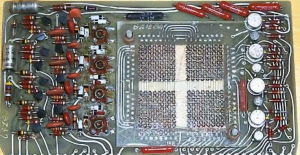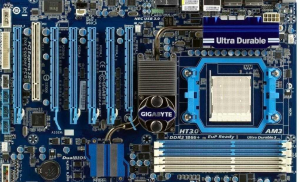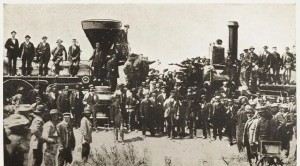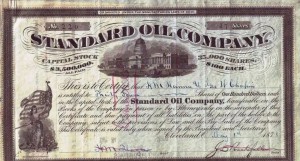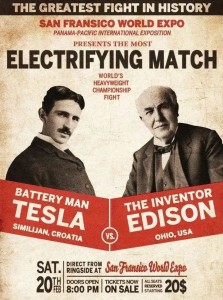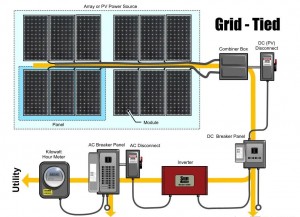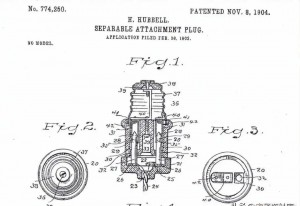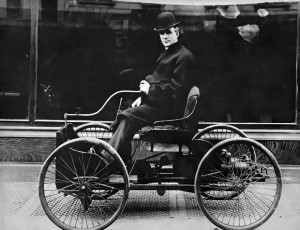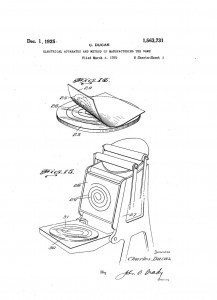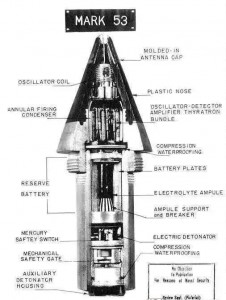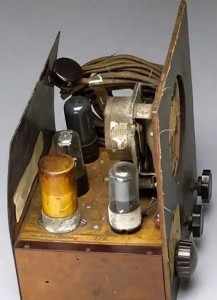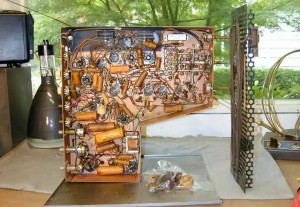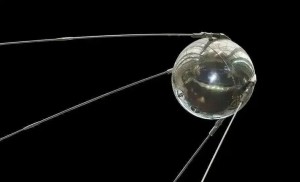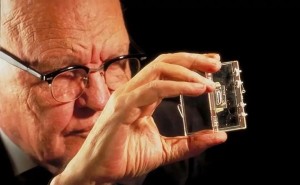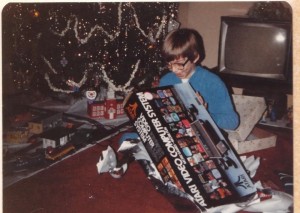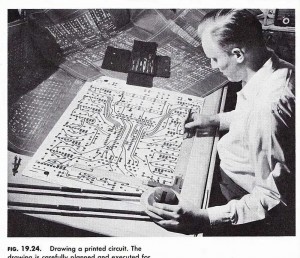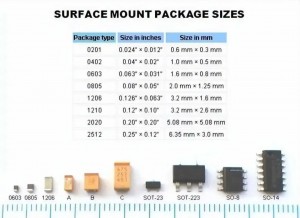Like many other great inventions throughout history, the printed circuit board (PCB) as we know it today is based on progress made throughout history. In our little corner of the world, we can trace the history of PCBs back more than 130 years, when the world’s great industrial machines were just getting started. What we will cover in this blog is not the complete history, but the important moments that transformed the PCB into what it is today.
Why PCB?
Over time, PCBs have evolved into a tool for optimizing the manufacture of electronic products. What was once easy to assemble by hand quickly gave way to microscopic components requiring mechanical precision and efficiency. Take the two boards shown in the figure below as an example. One is an old board from the 1960s for calculators. The other is the typical high-density motherboard you’ll see in today’s computers.
A PCB comparison between a 1968 calculator and today’s modern motherboards.
In a calculator we might have 30+ transistors, but on a single chip on a motherboard you’ll find over a million transistors. The point is, the rate of advancement in technology and PCB design itself is impressive. Everything on a calculator PCB can now fit into a single chip in today’s designs. This draws attention to several notable trends in PCB manufacturing:
We are integrating more functionality into advanced devices such as integrated circuits (ICs) and microprocessors.
We are shrinking passive components such as resistors and capacitors down to the microscopic level.
All of this leads to increased component density and complexity on our circuit boards.
All of these advances are primarily driven by improvements in the speed and functionality of our products. We expect our devices to respond instantly, even a few seconds of delay can drive us into a frenzy. For functionality, consider video games. Back in the 80s, you probably played Pac-Man at an arcade. Now we are seeing photoreal representations of reality. The progress is just insane.
Video game visuals are almost lifelike these days.
It’s clear that PCBs have evolved in direct response to what we expect from our devices. We need faster, cheaper, more powerful products, and the only way to meet these demands is to miniaturize and improve the efficiency of the manufacturing process. When did this boom in electronics and PCBs start? At the dawn of the Gilded Age.
Gilded Age (1879 – 1900)
We ended the American Civil War in the 60s, and now American manufacturing is booming. In the meantime, we are doing what we can, from food to clothes, furniture and rails. The shipping industry is on the offensive, and our greatest engineers are figuring out how to get someone from the east coast of the US to the west coast in 5 to 7 days instead of 5 to 7 months.
Railroads made travel from coast to coast take days instead of months.
During this time, we also brought electricity into the home, first in the cities and then in the suburbs and rural areas. Electricity is now a substitute for coal, wood and oil. Think of living in New York during the harsh winter, trying to cook or keep warm with dirty coals or piles of firewood. Electricity changed all that.
An interesting point is that Standard Oil, which monopolizes the oil market, does not supply oil for gasoline. Their market is oil for cooking, frying and lighting. With the advent of electricity, Standard Oil needed to define a new use for oil, which would come with the introduction of the automobile.
In May 1878, Standard Oil Company issued stock, and the oil monopoly began.
During the Gilded Age we saw some great discoveries in electromagnetism. We invented the electric motor, which converts electrical energy into mechanical energy. We also see generators, which do the opposite by converting mechanical energy into electrical energy.
It was also a time of genius inventors who still have an impact on our electronic world today, including:
Thomas Edison invented the light bulb in 1879, the movie in 1889, and many other innovations.
Nikola Tesla invented the electric motor in 1888 and the AC power source in 1895.
Alexander Graham Bell invented the telephone in 1876.
George Eastman’s Kodak invented the first consumer camera in 1884.
Herman Hollerith invented the tabulating machine in 1890 and went on to found IBM.
During this intense period of innovation, one of the biggest debates is that between AC and DC. Tesla’s alternating current eventually became the ideal method for transmitting power over long distances. Interestingly, however, we are still dealing with AC-DC conversion today.
AC may have won the battle, but DC still dominates electronics.
Look at any electronic device you plug into the wall, you need to convert AC to DC. Or, if you look at the infrastructure required for solar panels, they generate electricity in DC, which has to be converted back to AC as a power source, and back to DC for our devices to use. You could almost say the AC-DC debate was never over, a balance had just been struck between two opposing ideas.
There is a lot of back and forth between AC and DC in a solar panel.
Note that the original idea of the PCB was not invented in the Gilded Age. However, without the manufacturing capabilities of this era, and the widespread influence of electricity, PCBs would never be what they are today.
Progressive Era (1890 – 1920)
The Progressive Era was marked by a period of social reform, with legislation like the Sherman Antitrust Act breaking up Standard Oil’s monopoly. This is also when we see the first PCB patents. In 1903, German inventor Albert Hanson applied for a British patent for a device described as a flat foil conductor on a multilayer insulating board. Sound familiar?
Drawing depicting Albert Hanson’s first PCB patent.
Hansen also describes the concept of through-hole applications in his patent. Here he shows that you can punch a hole in two layers with vertical lines to make an electrical connection.
During this time, we began to see Edison and other business leaders make a big push to bring electric devices into everyday homes. The problem with this push is the complete lack of standardization. If you lived in New York or New Jersey and used Edison’s inventions of electricity for lighting, heating or cooking, what would happen if you used them in another city? They can’t be used because each town has its own socket configuration.
The problem was also made worse by the fact that Edison didn’t just want to sell people a light bulb, he also wanted to sell a service. Edison could provide you with electricity service on a monthly basis; then you would buy light bulbs, appliances, etc. Of course, none of these services are compatible with other competing methods.
We want to thank Harvey Hubbel for finally putting an end to this mess. In 1915, he patented the standard wall socket plug still in use today. Now we don’t have a toaster or hot plate plugged into a light bulb socket. This is a huge win for industry standardization.
Thanks to Harvey Hubbel, we now have a standardized wall outlet for all electronic devices.
As a final note, the Progressive Era was marked by World War I. This conflict is purely focused on mechs and trench warfare. The PCB concept, or even basic electronics, is not used in military applications yet, but it will soon be.
Roaring Twenties (1920s)
With the end of World War I, we are now in the Roaring Twenties, which saw a huge boom in the American economy. For the first time in history, more people live in cities than on farms. We’re also starting to see chains and brands being introduced across the US. You might have a family store or two in two different towns, but now we have major brands and stores that go national.
The greatest invention of this period was Henry Ford’s automobile and the infrastructure it required. The situation is similar to the 1990s, when we had to build a major infrastructure to deal with the internet and our information age by building switches, routers, and fiber optic cables. Cars are no exception.
Henry Ford’s first car – a four-wheeler.
Here we see what was once a dirt road being paved. People needed gasoline to power their vehicles, hence the need for gas stations. You also have repair shops, accessories and more. Many people’s entire way of life originated from the invention of the automobile, and it still is today.
It was also during this time that we saw the introduction of modern appliances that we still rely on today, such as washing machines, vacuum cleaners and refrigerators. For the first time, people will be able to buy perishable goods in stores and store them for an extended shelf life.
But where are our PCBs? We still haven’t seen them used in any appliances or cars launched during this time. However, in 1925, Charles Ducasse filed a patent that described the process of adding conductive ink to insulating materials. This will later result in a printed wiring board (PWB). This patent is the first practical application similar to a PCB, but only as a planar heating coil. We haven’t gotten any actual electrical connections between the board and the components yet, but we’re getting close.
The PCB continued to evolve, this time being used as a heating coil for Charles Ducas.
Great Depression (1930s)
In 1929, the stock market plummeted, and all the great innovations of our time plummeted. Here we see a period of unemployment above 25%, 25,000 bank failures, and a lot of trouble around the world. It was a tragic time for humanity as a whole, paving the way for the rise of Hitler, Mussolini, Stalin, and our future world conflicts. PCBs may have been silent until now, but that’s all about to change.
The Great Depression affected everyone, from banks to ordinary workers.
World War II (1939 – 1945)
World War II was underway, and the United States joined the fray after the bombing of Pearl Harbor in 1942. What’s interesting about Pearl Harbor is the entire communication failure that led to the attack. The US had good evidence of an imminent crisis, but all methods of contact with their military base in Honolulu were unsuccessful, and the island was caught off guard.
As a result of this failure, the DoD realized they needed a more reliable means of communication. This brought electronics to the forefront as the primary means of communication replacing Morse code.
It was also during World War II that we saw the first use of PCBs in proximity fuses that we have today. The device is used for high-velocity projectiles that require long-distance precision fire in the sky or on land. The proximity fuze was originally developed by the British to counter the advance of Hitler’s army. It was later shared with the United States where the design and manufacture was perfected.
One of the first military applications to use PCBs was proximity fuses.
During this time, we also had Paul Eisler, an Austrian living in the UK, patenting copper foil on a non-conductive glass substrate. Sound familiar? This is a concept we still use today to make PCBs with insulation and copper on the top/bottom. Eisler took this idea a step further when he built a radio out of his PCB in 1943, which would pave the way for future military applications.
Paul Eisler built a radio out of the first printed circuit board (PCB).
Baby Boomers (1940s)
As World War II drew to a close, we saw our soldiers come home, start families, and have a whole bunch of kids. Cue the baby boomers. It was in the post-war era that we saw massive improvements to existing appliances such as vacuum cleaners, washing machines, televisions and radios. Now that the Great Recession is behind us, many consumers can finally afford these devices in their homes.
We still haven’t seen consumer grade PCBs. Where are the works of Paul Eisler? Take a look at this old TV below and you’ll see all the components, but without the underlying PCB foundation.
An old Motorola TV from 1948, no PCB.
Despite the lack of PCBs, we did see the arrival of the transistor at Bell Labs in 1947. It took another six years in 1953 before the device was finally used in production, but why so long? In those days, information was disseminated through journals, conferences, etc. Before the information age, the spread of information just took time to spread.
The first transistor was born at Bell Laboratories in 1947.
Cold War Era (1947 – 1991)
The advent of the Cold War era marked a considerable period of tension between the United States and the Soviet Union. Due to the differences between capitalism and communism, these two giants are almost at war with each other and have put the world under threat of nuclear annihilation.
To stay ahead in this arms race, both sides must improve their ability to communicate to understand what the enemy is doing. Here we see the PCB being used to its full potential. In 1956, the U.S. Army published a patent for a “circuit assembly process.” Manufacturers now have a way to both hold electronics and make connections between components with copper traces.
As PCBs began to take off in the manufacturing world, we found ourselves in the world’s first space race. Russia has had some amazing achievements during this time, including:
1957 Launch of the first artificial satellite, Sputnik
1959 Launch of Luna 2, the first spacecraft to the Moon
In 1961 Yuri Gagarin, the first cosmonaut, was sent to orbit the Earth
Russia’s first artificial satellite, Sputnik, launched in 1957.
Where is America in all of this? Mainly lagging behind, it usually takes a year or two to develop the same technology. Addressing this gap, we see the U.S. space budget grow fivefold in 1960. We also have the famous 1962 President Kennedy speech, part of which is worth quoting:
“We choose to go to the moon! We choose to go to the moon to do other things this decade, not because they are easy, but because they are hard; because this goal will help organize and measure our best energies and skills, because of this Challenges are what we are willing to take on, what we are not willing to postpone, and what we are willing to win.” – John F. Kennedy, President of the United States, September 12, 1962
All of this led to a landmark moment in history. On July 20, 1969, the first American man landed on the moon.
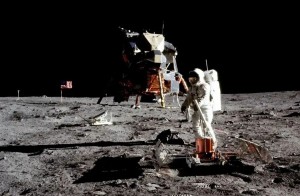
The first man on the moon, a historic moment for mankind.
Going back to PCBs, in 1963 we had Hazeltyne Corporation patent the first plated through-hole technology. This will allow components to be packed close together on the PCB without worrying about cross-connects. We also saw the introduction of Surface Mount Technology (SMT), developed by IBM. These dense assemblies were first seen in practice in a Saturn rocket booster.
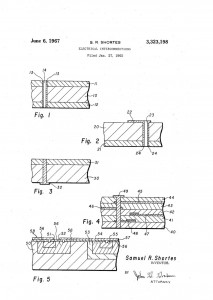
1967 The first through-hole PCB technology patent.
Dawn of the Microprocessor (1970s)
The 70s brought us the first microprocessor in the form of an integrated circuit (IC). This was originally developed by Jack Kilby of Texas Instruments in 1958. Kilby was new to TI, so his innovative ideas for ICs were largely kept under wraps. However, when TI’s senior engineers were sent to a week-long meeting, Kilby stayed behind and ran with the ideas in his head. Here, he developed the first IC in TI labs, and the returning engineers loved it.
Jack Kilby holds the first integrated circuit.
In the 1970s, we saw the first use of ICs in electronics manufacturing. At this point, if you’re not using a PCB for your connections, you’re in big trouble.
Dawn of the Digital Age (1980s)
The digital age has brought about a huge change in the media we consume, with the introduction of personal devices such as discs, VHS, cameras, game consoles, walkmans, and more.
In 1980, the Atari video game console made children’s dreams come true.
It’s important to note that PCBs were still drawn by hand using light boards and stencils, but then computers and EDA came along. Here we see EDA software like Protel and EAGLE revolutionize the way we design and manufacture electronics. Instead of a photo of the PCB, we can now save the design as a Gerber text file, whose coordinates can be entered into the fabrication machinery to produce the PCB.
The Internet Age (1990s)
In the 90s, we saw the use of silicon come into full swing with the introduction of the BGA. Now we can fit more gates on a single chip and start embedding memory and systems-on-chip (SoCs) together. This was also a period of high miniaturization of electronics. We didn’t see any new features added to the PCB, but the whole design process started to change and evolve, moving to the IC.
Designers must now implement design-for-test (DFT) strategies into their layouts. It’s not easy to pop a component and add a blue line. Engineers must design their layouts with future rework in mind. Are all these components placed in such a way that they can be easily removed? This is a huge concern.
It was also an era when smaller component packages like the 0402 made hand soldering of circuit boards nearly impossible. The designer now lives in his EDA software and the manufacturer is responsible for the physical production and assembly.
Surface mount components from largest to smallest.
Hybrid era (2000s and beyond)
Cut to today’s era of electronics and PCB design; what we call the hybrid era. In the past, we had multiple devices for multiple needs. You need a calculator; you buy a calculator. You want to play video games; you buy a video game console. Now you can buy a smartphone and get 30 different tiers of built-in features. This might seem pretty obvious, but it’s pretty astounding when you actually see all the things our smartphones can do:
gaming equipment address book e-mail barcode scanner flashlight bell camera navigation
music player schedule VCR map Internet browser calendar movie player calculator
Telephone notebook tickets recorder answering machine Short message banking books
We’re in the age of device consolidation, but what’s next? PCBs are established and we have processes and procedures for almost everything. High-speed applications are becoming the norm. We also see that only 25% of PCB designers are under the age of 45, while 75% are preparing to retire. The industry appears to be in a time of crisis.
Will the future of PCB design be robots? Maybe in a wearable with a flex circuit? Or we might see protons replace electrons with photonics. As far as what we know about physical PCBs, that might even change in the future. There is no need for a physical medium to enable the connection between components, but rather the potential of wave technology. This would allow components to send signals wirelessly without the need for copper.
What will the future hold?
No one really knows where the future of PCB design, or even electronics in general, is headed. It’s been nearly 130 years since our manufacturing muscles began to work. Since then, the world has changed forever with the introduction of major products like cars, appliances, computers, smartphones, and more. Gone are the days when we depended on coal, timber or oil for all our basic livelihoods and survival. Now we have electronic gadgets that can fulfill our daily needs.
But what does the future hold? This is a big unknown. We all know that every invention before us stands on the shoulders of its predecessors. Our ancestors brought PCB design to where it is today, and now we need to innovate and revolutionize the way we design and interact with technology. The future can be anything. The future depends on you.
Post time: Mar-17-2023

